 UK Royal Navy (1916-1945)
UK Royal Navy (1916-1945)1916 program: HMS Shakespeare, Spenser, Wallace, Keppel, Rooke, Saunders*, Stragge* (Built 1916-1920).
WW1 British Destroyers:
26 knotters | 27 knotters | 30 knotters | 33 knotters | Turbine destroyers | River class | Cricket class | Tribal class | Beagle class | Acorn class | Acheron class | Acasta class | L class | M class | Repeat M class | Medea class | Faulknor class FL | Marksman class FL | Parker class FL | Talisman class | Shakespeare class FL | R class | S class | Repeat R class | V class FL | Scott class FL | V class | W classThe Shakespeare or “Thornycroft Type” were Flotilla leaders which type was developed already in 1913, after acknowledging the failure of HMS Swift as an in-between cruisers and destroyers. Thus by October 1913 the admiralty worked on a new design, and started from the older Tribal type, trying to make it a proper flotilla leader with long range communication, better armament and extra staff facilities. This led to order the Lightfoote class destroyers leaders, launched in 1915 over a final design prepared by Cammell Laird. Then followed the four proposed by JS White as an alternative. The admiralty later worked on larger destroyers, the “V class” (launched 1917 ad a serie of derived flotilla leaders, the Vampire class, also launched in 1917).
Thornycroft then proposed to the admiralty for the War Emergency Programme in April 1916 its own, much larger design, called either the “Thonycroft type” or Shakespeare class, which proved a very influential one. Not only on the export market (many countries in the interwar adopted this design) but also formed the base for the next generation British interwar “A” class destroyers. This is a new cycle leading to WW2 and early cold war “classic destroyers” such as the Battle and Daring. As for the Skakespeare class, two were cancelled, two decommissioned in 1936 but Wallace, Keppel and Rooke took part in WW2, Rooke being sunk in 1942.
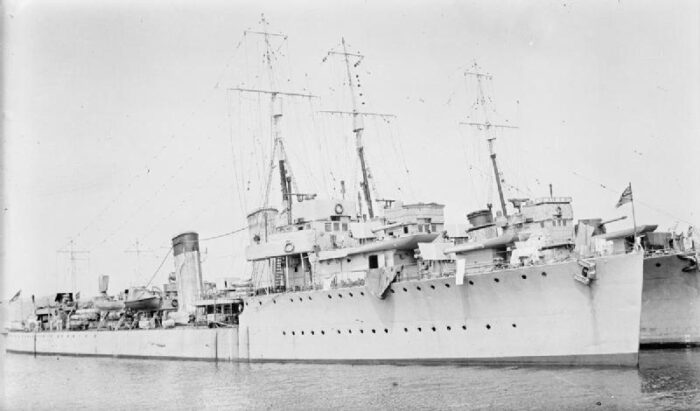
Development
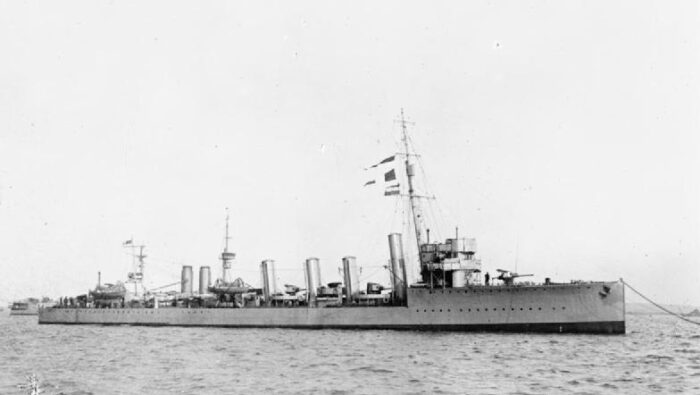
HMS Nimrod of the Marksman/Lightfoote class, the first true flotilla leaders
As said above, the road leading to this peculiar class of flotilla leaders, later used as a new standard for interwar destroyers worldwide, and making Thornycroft a leader in that regard, was not born from nowhere. The abysmal performances of HMS Swift, admiral Fisher’s attempt to design “the prefect scout”, faster and less well armed than a cruiser, ended pretty badly as a ship was seen a disappointing in many areas, starting with her powerplant.
Experience with Swift and the comparatively low speed of scout cruisers at the time confirmed the need for a new type of flotilla leader, based on a destroyer design. A conference of the War Staff in October 1913 proposed that a ‘Tribal’ class (Crusader, Maori or Zulu, or Swift herself) should be given Poulsen long-range wireless (150m range) and have the bridge enlarged to accommodate the additional Captain (D)s staff. However the Controller instructed the DNC (Directorate of Naval Construction) to prepare specifications for a leader not exceeding 1800t, with a speed of 33 to 34kts, 44in guns and 4 ‘anti-airship pom-poms’ etc. Accommodation would include Captain (D), an extra Lieutenant, a WO for signal duties and 8 extra staff. The design had machinery similar to the ‘M’ class.
Although three were proposed, only two were approved: one each for the Ist and 3rd DF, a scout cruiser for the slower Acorn class in the 2nd DF, and Swift to lead 4th DF, all forming part of lst Fleet. The design was approved in December 1913 and it was suggested that their names should conform to the new initial letter of the floulla which they would lead, hence the names Lightfoot and Marksman. In April 1914 tenders were put out for two more, Kempenfelt and Nimrod, to be built under the 1914—15 Estimates. In August 1914 the 12—1pdr out of the total ordered for the 13 ‘M’ class and the first two leaders were transferred to the Army for use in France, so the design was altered to lapdr guns instead, but in February 1915 Vickers 2pdr pom-poms were substituted.
The four leaders were successful, providing sufficient extra space for the administrative and signal staff essential to the running of a large flotilla. In November 1914 three more were ordered, but this time they were given the names of angels in Milton’s Paradise Lost. One of them, Gabriel was selected in August 1915 for conversion to a minelayer but later the same month A bdatel took her place. She was given stowage for 80 mines, and when loaded sacrificed both sets of TT and Nos 3 and 4 guns. In mid-1918 the Gabriel was also converted to a minelayer, but only carried 60 mines. In 1917 Lightfoot was given two 14in TT for short-range ‘cold’ torpedoes for night action, p&s under the midships ‘bandstand’, and Nimrod was similarly converted.
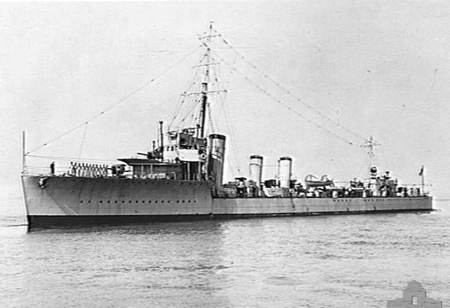
HMAS Anzac, Parker class flotilla leaders
Plans to use the new Arethusa class light cruisers as flotilla leaders were quickly dropped as the Grand Fleet was so short of scouting cruisers. There were, however, four big destroyers out of a batch of six ordered from J S White in Cowes by Chile in 1912. These were bought immediately on the outbreak of war. two were well advanced and the other two were on the stocks. The second pair, named Botha and Tipperary were bought in September 1914. The distribution of armament was altered; twin 21-in TT instead of four singles, and single 4-in guns on the forecastle and quarterdeck. In all four the l3-pdr guns were replaced by 2pdr Mk I pom-poms. In March 1918 Broke was rearmed with 2-4.7in (12cm)/45cal BL, one forward and one aft, retaining the tin guns on either side of the bridge (a request for 64.7in BL had to be turned down because of the weight). the remaining two ships were similarly rearmed by the Armistice. Tipperary was sunk by gunfire at Jutland; the remaining three were refitted and sold back to Chile in May 1920, as Almirante Uribe (ex-Broke), Almirante Williams (ex-Botha) and Almirante Riveros (ex-Faulknor)
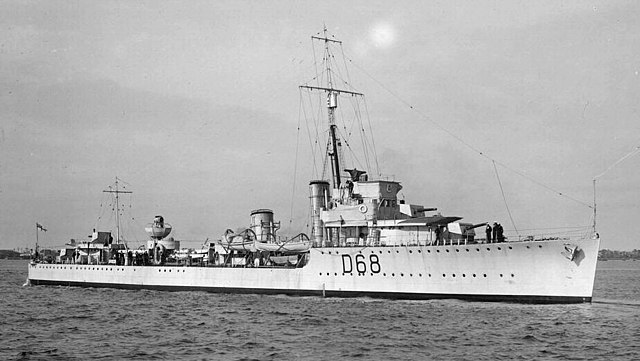
HMAS Vampire of the “V” class flotilla leaders. They were built as the modified “R” class destroyers promised to replace leaders, but failed to deliver. The DNC asked a 34 kts design which design was presented in April 1916. They repeated the armament of the Parker class leaders from Camell, which were repeat Kempenfelt class. The difference was in superimposed guns forward and aft. Accomodations were better and the bridge moved further aft on a 15ft shorter hull. It was estimated they wouldbe also 50,000£ cheaper than the Lightfoote and 6000£ more than standard M/R class DDs. One was built at White, two at Denny. The first went to the Australian Navy and took part in WW2, one sold 1931, one BU 1936 and the remainder saw action in WW2.
While the DNC was working on the design of the ‘V’ class leader, Thornycroft submitted their own series of designs for a leader. As it happened the DNC had been instructed to work out designs for a larger type of leader to match rumoured new German destroyers armed with Sin guns, and he reported that the addition of 5in guns to the Thornycroft design would fit the new requirement very well. As there was no Sin gun in the Navy’s inventory design of a new gun would take too long, and it was suggested that the Army’s 4.7in field gun should be adopted instead. This was done, and as a result the new leaders carried five 4.7in, superimposed forward and aft, as in the ‘V’ leaders, and a fifth gun on a ‘bandstand’ between the funnels. With their two sets of triple 2lin TT, this made the new leaders the most heavily armed destroyers in the world, and the addition of a 9ft rangefinder as well as torpedo sights on the bridge marked a vast improvement in fighting efficiency. With their massive flat-sided funnels and heavy armament the Shakespeare class made a great impression, particularly among other navies.
The first two, Shakespeare and Spenser, were ordered in April 1916, followed by Wallace in April 1917 and the remainder in April 1918. Two were cancelled, and Rooke and Keppel were Slowed down after the Armistice. Two more, Barrington and Hughes, were to be built by Cammell Laird because Thornycroft’s Woolston yard was full to Capacity in the spring of 1918, but the DNC decided that Cammell Laird would be unable to match the weight-saving techniques, and the orders were replaced by Scott class vessels with the same names. Rooke was renamed Broke in April 1921; completed by Pembroke DYd in January 1925. Shakespeare was handed over (with Spenser, Valkyrie, Vectis, Venturous and some ‘S’ class) for BU in September 1936 in exchange for the old liner Majestic (later HMS Caledonia).
Design of the class

The DNC worked on larger type of leaders to match rumoured new German destroyers armed with 127mm guns and this was reported to Thornycroft design whuic soon submitted its own design, improving the V class at all levels. Since there was no time to develop a new 127mm gun it was suggested to adopt the army 120mm field gun instead, adapted to naval use. As a result the new leaders would have five 120mm with two superimposed fore and aft and one on a bandstand between funnels combined with two sets of triple 533mm TT making them the most heavily armed destroyers in the world (even compared to Russian Novik-derivatives) whereas fire control was greately improved by the adotion of a 2.7m rangefinder and new torpedo sights on the bridge.
The Thornycroft type leader or Shakespeare class designed and built at John I. Thornycroft & Company in their Woolston, Southampton Yard for the Royal Navy were all named after historical naval leaders but only the first two, Shakespeare and Spenser were completed in time for wartime service. Saunders and Spragge were cancelled in April 1919. As flotilla leaders they were tailored to carry the flag staff, with enlarged accomodations for additional crew as well as offices and signalling equipment. The extra lenght has also another benefit, it freed space amidship to install a fifth gun. One more than the very similar, yet much smaller “Admiralty” type leader (built by Camell Laird), but it had Thornycroft proper design characteristics, notably its broad and slab-sided funnels, two of them.
Hull and general design
For the first time for seaworthiness the forecastle was extended further aft, for more than 1/3 of the total lenght. The extra lenght of the design made it more capable to ride high waves and make it far more seaworthy than any other class prior. In dimensions and tonnage, this was also another level. They displaced 1,480 tons standard and 2,009 tons full load. Symbolically, they passed the 2,000 tonnes mark whereas all previous flotilla leaders were below 1900 tonnes fully loaded.
They were also longer, at a sumbolic 100 meters or 329 ft overall, for a 31 ft 6 in (9.60 m) beam and 12 ft 6 in (3.81 m) in mean draught. The bow was large and flared, and the waterline was much refined to reach top speed. There was also a reworked poop with finer lined around the rudder. The beam was near constant past the “B” mount, and started to inflex towards the bow at the level of the second torpedo tubes bank. The poop had nice ellipses up to the max beam too. The bow was near straight or “slight clipper”. Particular attention was paid to the top weight and way the machinery, ammunition and fuel oil tanks were located to alleviate the superfring guns main and aft and the two amidships guns on their bandstands.
Powerplant
The Thornycroft type capitalized on its experience for integrating steam turbines, and the class was equipped of Brown-Curtis single reduction turbines, feeding four Yarrow-type boilers for a grand total of 40,000 shp (29,830 kW) in output, which was way above the 27,000 hp of the previous Vampire class leaders, and the 36,000 of the earlier Parker class. As a result they were capable of blasting speeds, 38 knots (70 km/h) on trials, which was amazing back in 1917, making them the fastest ships afloat, and a more realistic 36 knots (67 km/h) in service; which was standard. The V class could only reach 34 knots. For range, they counted on 500 tons of oil instead of 367t, enough for an estimated range of 5000 nautical miles at 15 knots cruise speed.
Armament
BL 4.7 in/45 Mark I
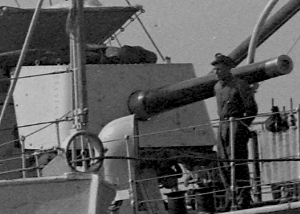 Five of them installed on superfiring positions fore and aft and an extra one planted on a raised platform between the two funnels, usable for broadsides. Developed in 1918 for the Mark I and adopted for the new class, they were built in limited quantities, the Mark II by 1940.
Five of them installed on superfiring positions fore and aft and an extra one planted on a raised platform between the two funnels, usable for broadsides. Developed in 1918 for the Mark I and adopted for the new class, they were built in limited quantities, the Mark II by 1940.
The Mk I weighted 7,000 pounds (3,200 kg) for a 213 inches (5.4 m) bore (45 calibres) barrel
It fired a 50 pounds (22.7 kg) 4.724 inches (120 mm) shell at 2,670 feet per second (814 m/s)
It used a Welin breech block for 5-6 RPM
Elevation was -9.5° to +30° with 240° traverse, range 15,800 yards (14,450 m) at 30°.
These were all shielded, just enough to cope with light shrapnel (c5 mm).
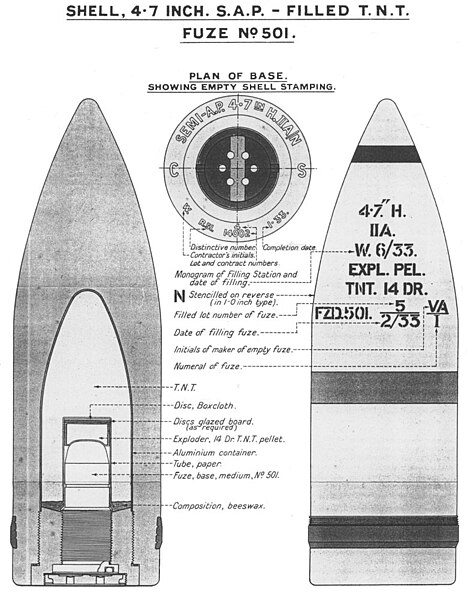
12 pdr HA Mark VIII AA
This single gun was installed on a raised platform aft of th second funnel, close to the forward torpedo tubes bank.
Long derived from a large serie started back in 1894 part of the QF 12 pdr 12 cwt for anti-torpedo boat purposes, this gun was declined later in 1914 to the HA Mark VIII and HA/LA IX by late WW2, both anti-aircraft guns. The Mark II was later replaced by the Mark VIII was a 7.62 cm caliber model 45 caliber 20 cwt capable of a -10° to +90° elevation an the mount weighted 2.10 tons (2,134 kg).
it was capable of 15 rounds per minute with a muzzle velocity of 2,210 ft/s (670 m/s) and an effective firing range of 11,750 yd (10,740 m) at 40° elevation.
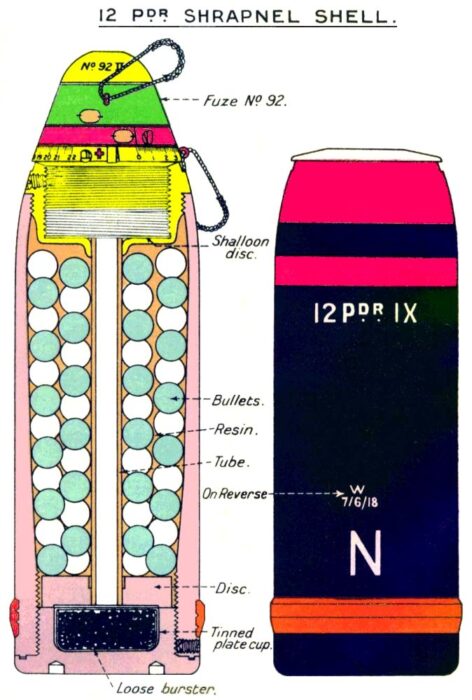
21-in torpedo tubes
The two triple banks were located aft of the structure behind the second funnel, with the searchlight platform installed in between. The two banks were assorted with cranes fir reload at sea. Spare torpedoes were likely stored alongside the aft and amidship deck structures. The banks were narrow due to the third tube being mounted over the two others.
They were likely of the 21″ (53.3 cm) Mark IV* typed entering service in 1917.
Weight: 3,206 lbs. (1,454 kg), lenght 22 ft 7.5 in (6.896 m).
Payload 515 lbs. (234 kg) TNT.
Powered by Wet-heater.
Range/Speed settings 8,000 yards (7,300 m)/35 knots, 10,000 yards (9,150 m)/29 knots or 13,500 yards (12,350 m)/25 knots
⚙ specifications Shakespeare 1918 |
|
| Displacement | 1,480 tons standard, 2,009 tons full load |
| Dimensions | 329 ft x 31 ft 6 in x 12 ft 6 in (100 x 9.60 x 3.81 m) |
| Propulsion | 2 shafts Brown-Curtis single reduction turbines, 4× Yarrow-type boilers 40,000 shp (29,830 kW) |
| Speed | 38 knots (70 km/h) trials, 36 knots (67 km/h) service |
| Range | 500 tons oil, 5000 nm at 15 knots |
| Armament | 5× BL 4.7 in Mark I, 1× 12 pdr HA Mark VIII, 2×3 21 in torpedo tubes |
| Sensors (ww2) | |
| Crew | 164 |
Interwar and Wartime Modifications
Powerplant
Broke and Keppel had their engine power reduced to be better suited for Atlantic escorts. One boiler was removed from Broke in April 1942, and one from Keppel in March 1943 almost a year later. The result was that space was used for an extra 75t bunkerage, which rose to 575t on both ships. The full displacement between armament reductions in some areas and augmentations on others, rosed to 2,280 tonnes fully loaded instead of 2009 tones, so 280 tonnes, c80 for the oil, so 200y or extra ordnance. Engine power after the removal of one boiler was almost halved down to 25,000 hp and yet still, the top speed was maintained to 28kts. This was more than enough to chase any surfaced U-boat.
Armament
In the 1930s the now obsolete Vickers 40mm/39 or 2-pdr pompom was removed from the platform, they were replaced by Vickers 76mm or 3-inches/45 QF DP guns.
HMS Wallace was the first rearmed and rebuilt between late 1938 and June 1939. She was a prototype fo oceanic escorts. All her main guns but one (B) were removed, as her 3-in DP gun, and her tw triple TT banks. Instead she was fitted with two twin dual purpose 102mm/45 QF Mk XVI, on A and Y positions. On the inter-funnel bandstand, a quad 40mm/39 2pdr QF Mk VIII pompom was installed as well as two quadruple tandem 12.7mm 0.5 inches/62 heavy machine guns and a radar (see below).
In late 1940 HMS Broke and Keppel received a more auster modernization, loosing just one main gun in the bandstand position, replaced by two single 40mm/39 Mark VIII pompom AA guns whereas their depht stage stowage rose to 50 charges. They kept their poop racks. In 1941 they lost their “Y” gun aft, in received two depht chathe throwers while their provision was augmented to 70 depth charges. In april 1942 HMS Broke had a deeper refit, loosing her “A” main gun, replaced by a 24 tubes 178 mm Hedgehog ASWRL. Thius was completed by four depht charge throwers aft (now 8 total) and a complement of 98 charges. Keppel had the same upgrades later and had engine modifications in early 1943.
20 mm Oerlikon guns Mark II or IV either provided under lend lease or from Ruislip, London, delivered from March-April, 1941. They started to be installed on HMS Wallace in 1942, two single replacing their quad 0.5 inches Vickers HMGs. Keppel received theirs in 1942 and Broke later that year. Keppel received a third one in April 1943 during her reconstructionand wallace had two more in 1944-45.
Two extra pompom were installed on Keppel in 1943. As for depht charges, they rose to 140 on Keeppel after the same modifications. The weight taken by the eight DCTs was compensated by the losst of three main guns.
Sensors
Additions commenced in the 1920s already. Sjakesepeare somewhere in the 1920s received the newly developed Type 114 sonar and Spencer received the Type 115 sonar (see below). In the 1930s the whole class was aquipped with the now standardized Type 124 or 127 sonars. HMS Wallace in 1939 was the first to receive a radar, the Type 286. In 1941 these were swapped for a combination of the Type 271 and 285 radars.
Sonars
Type 114: no data
Type 115: no data
Type 124: From 1937, improved Type 121, range 2500 yards, 1st with chemical range recorder.
Type 127: From 1940, mostly installed on British Flower class sloops, first with a bearing plotter.
Type 144: From 1943, range 2500 yards (2300 meters) to 3000 yards (2700 meters), integrated into the fire control and coupled with Hedgehog. 1st with bearing recorder, automatic scanning, turning 5 degrees after each ping, often coupled with the Type 147 “Sword” depth finding sonar with a beam steerable vertically. Also coupled with the Q attachment reducing the under hull blind spot. 60° deep vertical beam, trained with the main Type 144 transducer.
Radars
Type 286/286P: Naval air search radar, first destroyer set, very crude, not rotating. Full data 286P: rotating antenna, better bearing accuracy of 3-5 degrees.
Type 271: Corvette small surface search radar using a standard microwave-frequency system with improved resolution to spot surfaced U-boat 3 miles (4.8 km) around, or a periscope at 900 yards (820 m). Full data
Type 285: Anti-aircraft gunnery radar available from late 1940, Frq 600 MHz, power 25 kw, range 18,000 yd (16,000 m), ceiling 15,000 ft (4,600 m) accuracy 150 yd (140 m).

⚙ specifications Broke/Keppel 1942-43 |
|
| Displacement | 2,280 tons full load |
| Speed | boiler removed, 25,000 hp, 28 knots |
| Range | 575 tons oil, -6000 nm at 15 knots |
| Armament | 2x 4.7 in/45, 2x 40mm/39 2pdr QF Mk VIII, Hedgehog ASWRL, 4x 20mm AA, 140 Dcs |
| Sensors (ww2) | Type 286P/271 radars, Type 144 sonar |
⚙ specifications HMS Wallace 1945 |
|
| Displacement | 2,145 tons full load |
| Speed | c34 knots (62 km/h) |
| Range | 409 tons oil, -5000 nm at 15 knots |
| Armament | 2×2 102/45 QF Mk XVI, 1×4 40mm/39 2pdr QF Mk VIII, 2x 40mm/39 2pdr QF Mk VIII, 2x 20ll/70 Oerlikon Mk II/IV AA, 30 DCs |
| Sensors (ww2) | Type 271, Type 285 radars |
Career of
 HMS Shakespeare (1917)
HMS Shakespeare (1917)
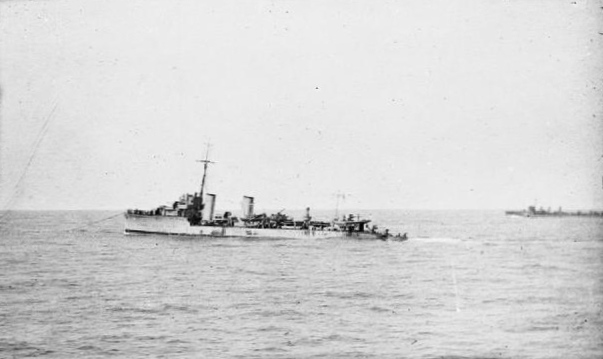
She was laid down 2 October 1916, launched 7 July 1917 and completed 10 October 1917. She had pos trials fixes made at Portsmouth and was assigned later to the 10th Destroyer Flotilla, Harwich Force on 14 November 1917. On 31 May 1918, she hit a mine off Harwich, killed one of her crew. She was towed back to port by HMS Centaur and stayed in repairs at Chatham Dockyard until 21 October 1918, but returned to see the end of the war with the 10th Flotilla.
Postwar she became leader of the new 2nd Destroyer Flotilla in Rosyth from March 1919. She was deployed in the Baltic Sea to support White Russians and by 18 May 1919, she wathced tje Bolshevik fleet in the Gulf of Finland, supporting Estonian forces. Whe four Bolshevik minesweepers sortied covered by the destroyer Gavriil, Shakespeare and Cleopatra (C class cruiser), Scout and Walker rushed towards them in interception, which was sufficient to have them withdrew behind minefields. They were engaged at long range and Gavriil received splinter damage.
On 21 June 1919 she was sent to inspect the German High Seas Fleet after its scuttling at Scapa Flow, Shakespeare being one of the first to respond to the alarm, attempting to take Emden under tow and beach her to avoid sinking. She was back in the Baltic from 12 August 1919 to support the Estonian offensive against Saint Petersburg. On 27 October she shelled the Red-held Krasnaya Gorka fort with the monitor Erebus, cruisers Delhi and Dunedin, fellow DD leaders HMS Mackay and Spensers plus four other destroyers. She was back home by November 1919.
She returned a third time to the Baltic in July 1920 just as hostilities ceased between Britain and the Bolsheviks. Back home in May 1921, she as reassigned as the leader of the 6th Destroyer Flotilla and deployed to Irish waters (9 May to 22 June 1921) to prevent smuggling of arms during the War of Independence. Later she joined the 7th Destroyer Flotilla at Rosyth from June 1922 but as “private ship”, relieved from the 6th by HMS Valhalla, and became official leader of the 7th from 27 September 1923.
From 21 December 1925 she entered reserve at the Nore, reassigned as reserve 9th Flotilla leader with skeleton crew. In 1927–1928 she was transferred to the Maintenance Reserve. But resources were lacking and condition deteriorated. Shakespeare was towed to Rosyth in March 1933 and inspected, the result was not good. On 19 August 1936 she had been decommissioned and sold for BU at Thos. W. Ward in exchange, replacing the ocean liner Majestic recuperated as a training ship.
 HMS Spenser (1917)
HMS Spenser (1917)
Spenser was laid down 9 October 1916, launched 22 September 1917 and completed 12 December 1917. She joined the 10th Destroyer Flotilla, Harwich Force on 15 December 1917, second in command of four leaders. On 26 January 1918 she collided with a sailing ship but rescued most of her crew. On 27 February 1918 she in the southern part of the North sea when attacked by a German Zeppelin. On 1 August 1918, the Harwich Force attacked German minesweepers together with six Coastal Motor Boats in the inner German Bight. CMBs could enter the minefields and search for the minesweepersn covered by the destroyers. They were spotted and atacked by a Zeppelin underway, Spenser dodging bombs. The same operation was relaunched on 10–11 August with fighter flying boats carried on three lighters, each towed by a destroyer and two more towed Sopwith Camel fighters on lighters iwht longer decks. The first for recce, the second to intercept Zeppelins. Without wind, the flying boats could not take off and CMBs continued on unescorted, later to be attacked by German aircraft, with three sunk, three damaged and later interned in the Netherlands. Meanwjile the destroyers were attacked by the airship L53, and a Camel managed to take off from towed by HMS Redoubt and shot her down. On 15 August 1918, Spenser rescued men from the torpedoed Scott and Ulleswater off the Dutch coast. The war ended in November in the same unit.
On 21 November, 1 December 1918 she escorted German U-Boats to Harwich to surrender. She joined later the 2nd Destroyer Flotilla at Rosyth, flagship for the Flotilla’s Captain (D) by March 1919. Like Shakespeare she was deployed in the Baltic Sea relieving the 1st Destroyer Flotilla. On 17/18 August she escorted seven CMBs into Kronstadt. They sank the submarine depot ship Pamiat Azova and damaged the battleship Andrei Pervozvanny loosing three CMBs. She also took on shore bombardment missioned line on 27 October on Krasnaya Gorka fort. She was home by November 1919 but returned in June 1920 and in September–October 1921 until hostilities ended. She was part of the Fleet Review at Spithead on 3 November 1923 and for King George V on 26 July 1924. By September she was versed to the 3rd Destroyer Flotilla, Mediterranean Fleet, until May 1925. Back in Portmouth on 6 June 1925 she saw no action and was planed in 1927 at the Maintenance Reserve. She was sent in Chatham in September 1927, Rosyth by April 1933 but decom. and stricken on 19 August 1936, sold for BU at Thos. W. Ward. (No cc photo)
 HMS Wallace (1918)
HMS Wallace (1918)
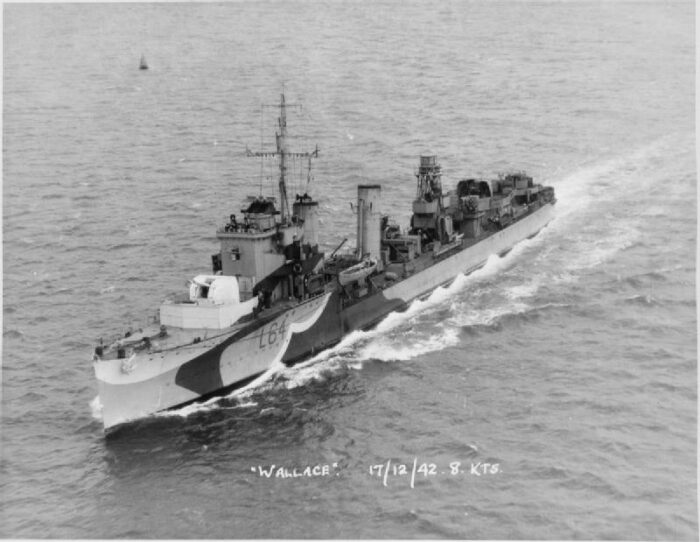
Wallace was laid down 15 August 1917, launched 26 October 1918 and completed 14 February 1919. She missed WWI but would have quite a career in WW2. Post-trials, she joined the 1st Destroyer Flotilla as leader for Captain (D) and by May 1919 entered the Baltic Sea. 31 May while off Seskar in the Gulf of Finland, escorting the cruiser Cleopatra, Dragon and Galatea and close to a Russian defensive minefield, they were attacked by the Russian destroyer Azard supported by the battleship Petropavlovsk. HMS Walker was hit twice by Petropavlovsk but the Russians withdrew. They were relieved by the 2nd Destroyer Flotilla in August 1919, Wallace being back in November. However part of the Flotilla mutinied and deserting she ships before departure, so that the crews were completed from battleships.
In May 1920 she was deployed in Irish waters (War of Independence) and in 1921, she joined the 1st Destroyer Flotilla. In September 1922 with the Chanak Crisis between Britain and Turkey under Mustafa Kemal, the 1st Destroyer Flotilla was deployed in Chanack (Çanakkale) on 4 October but diplomatic measures avoided war and she was back home in May 1923. She was present at the Spithead reviaw of 3 November 1923 and ha a refit in June-November 1924. By May 1925 she was in the renamed 5th Destroyer Flotilla as leader, refitted in June–November 1926 and Dec. 1931 to June 1932, then entered the Maintained Reserve at Portsmouth until 1938. Then her conversion started conversion to a “Wair”-type anti-aircraft escort followed by trials on 22 May 1939, full acceptance on 14 June. She trained the RN Volunteer Reserve at Liverpool and was sent to Rosyth on 31 August and started convoy escorts along the east coast.
On 13 September 1939 she collided with the merchant Redriff off Lowestoft, badly damaged, holed at her waterline but assisted by the destroyer Wanderer, and towed to Harwich, repaired from 21 September to 22 October. On 12/13 December she recued members of the steamer Amble which struck a mine. On 27 February 1940, she rescued members of the French steamer PLM 25 which hit two mines at the Cromer Knoll lightvessel minefield laid by German DDs like before. On 1 March same story for the Italian merchant ship Mirella, torpedoed by U-20 and steamer Albano, mine again.
She was refitted by June–July 1941. On 22 February 1942, she collided wth the merchant ship SS Fulham VI. On 31 March she linked to escort ten Norwegian merchant ships trapped in Gothenburg through the Kattegat and Skagerrak while evading German forces. But only two made it,, the tankers B. P. Newton and Lind. On 16 May 1942 she was attacked and damaged by German bombers, towed into Sheerness by the the French Flower class corvette Guillemot. She was repaired at the East India Docks. From June 1942 she had in her crew sub-lieutenant Prince Philip, Duke of Edinburgh, while on patrol on east coast.
In June 1943, she was detached for Operation Husky, the Allied invasion of Sicily, escorting the assault Convoy KMF 18 (1st Canadian Division) from Bône (Algeria) to “Bark West” at Pachino on 10 July. Prince Philip as 1st lieutenant, second in command suggested to foil night bomber attack b launching a raft with smoke floats to distracted bombers.
Back to East coast convoy she was repaired for her worn out machinery several times in 1943, 1944 and 1945. On 16 March she collided with the destroyer Farndale and not repaired but placed in Category C reserve on 12 April and sold for BU.
 HMS Keppel (1920)
HMS Keppel (1920)
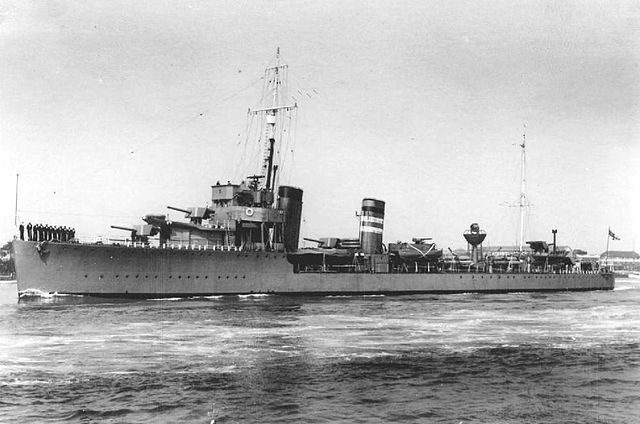
Keppel was launched on 23 April 1920 and completed 1925 by HM Dockyard Portsmouth. Sge served on many stations in the interwar, Mediterranean and Far East and was placed in reserve in 1937 but re-commissioned in August 1939. She was sent to Gibraltar as leader of 13th Destroyer Flotilla. In June 1940 she took part in Operation Dynamo off Dunkirk and later in August 1940 to Operation Catapult, the attack on Mers el Kebir. Later she was reassigned to Scapa Flow’s 12th Destroyer Flotilla in fleet escort duty and rpepared for the probable German invasion which never took place.
In February 1941 she patrolled the Western Approaches, Atlantic convoys as leader of 12th Escort Group from Londonderry. In total she escorted more than 30 North Atlantic and over 12 Gibraltar convoys, six being attacked, 20 ships lost and seeing four major convoy battles but protected over 1000 ships and claimed an U-boat, assisted two more.
Sge was deployed in the dreaded Arctic convoy route, escorting 15 convoys at at this occasion she attacked and claimed four U-boats.
in March 1942 she fought U-587 attacking the convoy WS 17, coordinating several units of the escort group to sink her. In July 1942 she was part of the infamous PQ 17 which was scattered.
In September 1942 she was in the Distant Cover Force for PQ 18 and QP 14.
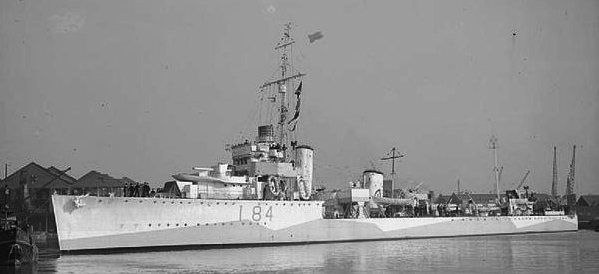
In May 1943 she ecorted HX 239, when deceting and attacking U-752, destroyed by the escort group. In September 1943, she defended ONS 18, (6 merchants, 3 escorts sunk by a wolfpack) for three U-boats, U-229 by Keppel alone. In January 1944 she was back on Arctic convoys and by February escorted JW 57, spotting and sinking U-713 and on the return RA 57 co-claimed three U-boats, two more damaged. In April 1944 while escorting JW 58, she spotted, rammed and sank U-360 in poor visibility. Three more were sunk. In the summer of 1944 she was transferred to the Channel for Operation Neptune (Normandy landings). In August 1944 while escorting JW 59, she co-claimed U-354. With RA 59A, she co-claimed U-394. She was worn out when decommissioned by June 1945 and sold for BU in July 1945.
 HMS Rooke/Broke (1920)
HMS Rooke/Broke (1920)
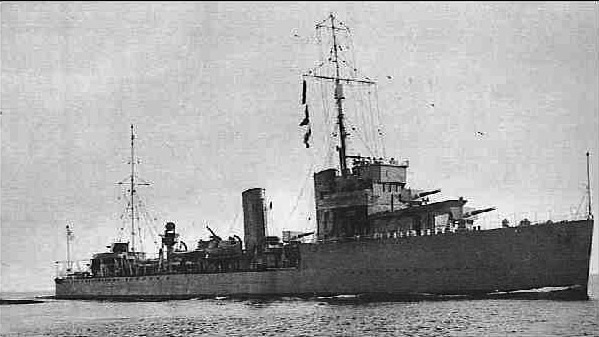
Launched 16 September 1920, completed January 1925 by HM Dockyard Pembroke she was renamed HMS Broke. She was the only one in her class sunk in action. Missing WI she was after trials and workup ordered to the Mediterranean, Malta on 9 February 1925 to relieve HMS Montrose as leader of the 4th Destroyer Flotilla. She stayed here for almopsty a decade, refitted at Malta in 1929 and in 1931. She was back home on April 1931, reserve at Devonport, tender to the RN Engineering College at Keyham until April 1932 and Emergency destroyer at Devonport. In June 1935 she was fully crew and assigned independent command, Reserve Fleet, then flagship for the Rear Admiral, Reserve Fleet in the Review of July 1935 and back to Portsmouth reserve. She was in an October 1935 movie based on C. S. Forester’s novel Brown on Resolution.
She was refitted at Devonport from September 1936 to March 1937 (boilers re-tubed) and resume her role. On 2 September 1937 she investigated a SOS signal from the South African merchant Sherard Osborn in the Bay of Biscay, signalling an imminent mutiny. On 20 November she collided with HMS Witch, repaired at Devonport from 31 December 1937 to 28 January 1938. Fully recommissioned in 1938, she revlieved Codrington as leader when refitted until October 1938, but was refitted at Devonport January-June 1939. She was assigtned in September to the 29th Division, 15th Destroyer Flotilla in Rosyth for convoy protection, Western Approaches from October. During her early WW2 service, her captain Richard Iwan Alexander Sarell was awarded a DSO on 23 December 1939 for “successful actions against enemy submarines”.
On 11 March 1940 she seached for U28 with Wild Swan and Winchelsea, after attacking the Dutch tanker Eulota. She found her scuttled her wreck while the crew was rescued. On 28 April she ran aground on the Goodwin Sands, quickly refloated. By May 1940 she had boiler repairs at Devonport and missed the Dunkirk Evacuation but took part int the later Operation Cycle, from Le Havre and Saint-Valery-en-Caux on 10-13 June. From 15 June she took part in Operation Aerial, including British, French troops, Civilians and 180 Polish troops and 20 British civilians from Brest on 18 June.
In July 1940, she joined 6th Escort Group on the Gibraltar-South Atlantic, then North Atlantic routes for 2.5 years escorting 30 north-south convoys. The naturalist and painter Peter Scott, part of the crew obtain permission to try in July 1940 and experimental camouflag, blue-grey all over starboard, countershaded with white and “bright pale colours” for shape disruption. Amm shadowed areas were painted white. She also escorted 27 east-west convoys. She was refitted at Harland & Wolff in January-March 1941 and stiffened to battle the north Atlantic in winter. On 6 April 1941 she assisted the AMC Comorin which caught fire in the North Atlantic. She pikced up 180 men and scuttled her with a torpedo. On 26 July 1941 while in convoy SL 80, she collided with the destroyer Verity near Derry, having a badly damaged bow, repair by Palmers, Hebburn yard in August-September.
Next she escorted the 6th Group from Londonderry. By October 1941 she escorted Convoy ONS 29 but retruend to port on 15 January 1942 due to engine problems, starboard engine dead and port engine intermittent, refitted at Portsmouth February and 25 July 1942, converted to a short-range escort. She was caught in the battle to protect SC 94 in August 1942 (11 ships sunk, two U-boats destroyed) under command of Arthur Layard, himself attacking U-595.
On 8 November 1942 with HMS Malcolm she took part in Operation Terminal, part of Operation Torch in North Africa. Under Captain Henry Fancourt they tried to land infantry directly into the port of Algiers to captute port facilities, preventing their destruction by Vichy French forces. But the latter opened fire with shore batteries point-blank. Malcolm managed to withdraw, but Broke manage to cut through the boom, landing her troops under heavy fire on the Quai de Fécamp before withdrawing at 10:30 but badly mauled by shore batteries, taken in tow by the HMS Zetland. She was abandoned and sank on 10 November.
Read More/Src
Books
Cocker, Maurice Destroyers of the Royal Navy, 1893-1981, 1983, Ian Allan
Conway’s All the World’s Fighting Ships, 1922-1946, Ed. Robert Gardiner, Naval Institute Press
M. J. Whitley Destroyers of World War II, An International Encyclopedia, Arms and Armour Press, 1988
Links
nice depiction
navypedia.org/ships/
dreadnoughtproject.org
dreadnoughtproject.org Parker_Class
worldnavalships.com /lightfoot_class
navweaps.com/ Brit Tops
en.wikipedia.org Thornycroft type Leader
en.wikipedia.org Parker-class
Model Kits
None found

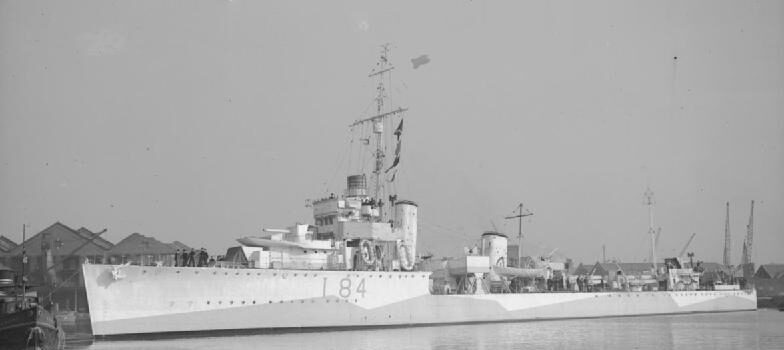
 Latest Facebook Entry -
Latest Facebook Entry -  X(Tweeter) Naval Encyclopedia's deck archive
X(Tweeter) Naval Encyclopedia's deck archive Instagram (@navalencyc)
Instagram (@navalencyc)





 French Navy
French Navy Royal Navy
Royal Navy Russian Navy
Russian Navy Armada Espanola
Armada Espanola Austrian Navy
Austrian Navy K.u.K. Kriegsmarine
K.u.K. Kriegsmarine Dansk Marine
Dansk Marine Nautiko Hellenon
Nautiko Hellenon Koninklije Marine 1870
Koninklije Marine 1870 Marinha do Brasil
Marinha do Brasil Osmanlı Donanması
Osmanlı Donanması Marina Do Peru
Marina Do Peru Marinha do Portugal
Marinha do Portugal Regia Marina 1870
Regia Marina 1870 Nihhon Kaigun 1870
Nihhon Kaigun 1870 Preußische Marine 1870
Preußische Marine 1870 Russkiy Flot 1870
Russkiy Flot 1870 Svenska marinen
Svenska marinen Søværnet
Søværnet Union Navy
Union Navy Confederate Navy
Confederate Navy Armada de Argentina
Armada de Argentina Imperial Chinese Navy
Imperial Chinese Navy Marinha do Portugal
Marinha do Portugal Mexico
Mexico Kaiserliche Marine
Kaiserliche Marine 1898 US Navy
1898 US Navy Sovietskiy Flot
Sovietskiy Flot Royal Canadian Navy
Royal Canadian Navy Royal Australian Navy
Royal Australian Navy RNZN Fleet
RNZN Fleet Chinese Navy 1937
Chinese Navy 1937 Kriegsmarine
Kriegsmarine Chilean Navy
Chilean Navy Danish Navy
Danish Navy Finnish Navy
Finnish Navy Hellenic Navy
Hellenic Navy Polish Navy
Polish Navy Romanian Navy
Romanian Navy Turkish Navy
Turkish Navy Royal Yugoslav Navy
Royal Yugoslav Navy Royal Thai Navy
Royal Thai Navy Minor Navies
Minor Navies Albania
Albania Austria
Austria Belgium
Belgium Columbia
Columbia Costa Rica
Costa Rica Cuba
Cuba Czechoslovakia
Czechoslovakia Dominican Republic
Dominican Republic Haiti
Haiti Hungary
Hungary Honduras
Honduras Estonia
Estonia Iceland
Iceland Eire
Eire Equador
Equador Iran
Iran Iraq
Iraq Latvia
Latvia Liberia
Liberia Lithuania
Lithuania Mandchukuo
Mandchukuo Morocco
Morocco Nicaragua
Nicaragua Persia
Persia San Salvador
San Salvador Sarawak
Sarawak Uruguay
Uruguay Venezuela
Venezuela Zanzibar
Zanzibar Warsaw Pact Navies
Warsaw Pact Navies Bulgaria
Bulgaria Hungary
Hungary

 Bundesmarine
Bundesmarine Dutch Navy
Dutch Navy Hellenic Navy
Hellenic Navy Marina Militare
Marina Militare Yugoslav Navy
Yugoslav Navy Chinese Navy
Chinese Navy Indian Navy
Indian Navy Indonesian Navy
Indonesian Navy JMSDF
JMSDF North Korean Navy
North Korean Navy Pakistani Navy
Pakistani Navy Philippines Navy
Philippines Navy ROKN
ROKN Rep. of Singapore Navy
Rep. of Singapore Navy Taiwanese Navy
Taiwanese Navy IDF Navy
IDF Navy Saudi Navy
Saudi Navy Royal New Zealand Navy
Royal New Zealand Navy Egyptian Navy
Egyptian Navy South African Navy
South African Navy






























 Ukrainian Navy
Ukrainian Navy dbodesign
dbodesign